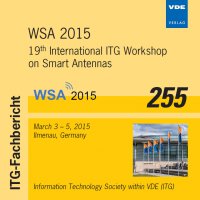How Many Transmit Antennas Emulate the Performance of Noise-Limited Systems?
Konferenz: WSA 2015 - 19th International ITG Workshop on Smart Antennas
03.03.2015 - 05.03.2015 in Ilmenau, Deutschland
Tagungsband: WSA 2015
Seiten: 6Sprache: EnglischTyp: PDF
Persönliche VDE-Mitglieder erhalten auf diesen Artikel 10% Rabatt
Autoren:
Bazzi, Samer; Dietl, Guido (DOCOMO Euro-Labs)
Dietl, Guido (University of Applied Sciences Landshut, Germany)
Utschick, Wolfgang (Fachgebiet Methoden der Signalverarbeitung,Technische Universität München, Germany)
Inhalt:
Cooperative precoding techniques in MIMO interference channels (ICs) such as interference alignment (IA) overcome interference, create noise-limited ICs, and achieve a linear rate scaling at high signal-to-noise ratios (SNRs). Alternatively, interference is overcome with the simple deployment of large transmit arrays, as interference becomes negligible by the law of large numbers. In such a case, ”selfish” precoding techniques such as maximum ratio transmission (MRT) constitute a good solution. We investigate how many transmit antennas are needed for MRT to emulate the performance of a noiselimited system, i.e., to perform similarly to a system where transmitters have a fixed number of antennas and employ the IA strategy. Assuming a time-division-duplex mode, we calculate the training overheads associated with channel state information acquisition for each precoding type, and include these in the spectral efficiency calculations. We use existing analytical rate expressions for IA and MRT. The rate and overhead analysis allows finding the required number of antennas in closed-form, which varies significantly according to the SNR and coherence interval length. Results for different scenarios and practical SNRs show that transmitters with few dozens of antennas at most using MRT perform similarly to transmitters with four antennas using IA. The main findings of this paper are that the simple MRT strategy does not require massive configurations to emulate the performance of noise-limited systems.


